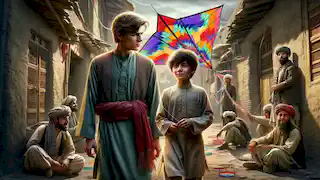Introduction Paragraph:
"The Kite Runner" is the debut novel of Afghan-American author Khaled Hosseini, published in 2003. The story is a profound exploration of guilt, redemption, betrayal, and forgiveness, told through the lens of Amir, a young boy from a wealthy family in Kabul, Afghanistan. The novel is set against the backdrop of the fall of Afghanistan's monarchy, the Soviet invasion, and the rise of the Taliban regime, bringing to light the political, social, and cultural upheaval in the country during these events. The narrative navigates the complex relationship between Amir and his servant and friend, Hassan, while also addressing themes of privilege, prejudice, and personal responsibility. "The Kite Runner" remains a deeply emotional tale about friendship, loyalty, and the burden of the past.
Summary of "The Kite Runner" by Khaled Hosseini
Part One: Childhood in Kabul
The novel begins in San Francisco in 2001, when Amir, the protagonist, receives a phone call that changes the course of his life. He reflects on his childhood in Kabul, Afghanistan, and the pivotal moment that has haunted him for years. The narrative then shifts to Amir’s early years in the 1970s when he was a young boy growing up in a wealthy household with his father, Baba, a larger-than-life figure, and their Hazara servants, Ali and his son Hassan. Hassan, though a servant, is Amir’s best friend, and they share a deep bond despite the differences in their social status and ethnic background—Amir is a Pashtun, while Hassan is a Hazara, a marginalized ethnic group in Afghanistan.
Amir, however, is plagued by his desire for his father's approval and often feels overshadowed by Hassan's loyalty and bravery. Baba, Amir's father, is a man of principles and strength, and Amir is desperate to live up to his expectations, but their relationship is strained by Amir's sensitivity and perceived weakness. Baba admires Hassan's courage and honesty, which makes Amir jealous and fuels his internal conflict.

A major event in Amir’s childhood revolves around the annual kite-flying tournament in Kabul, a highly anticipated and competitive event. Amir is determined to win the tournament to earn his father's admiration, and Hassan, known for his exceptional skill as a "kite runner," promises to retrieve the last kite Amir cuts down. In a moment of triumph, Amir wins the tournament, but his victory is overshadowed by a horrific incident that unfolds afterward. Hassan is brutally assaulted by Assef, a sadistic bully, and Amir witnesses the crime but is too scared to intervene.
This moment marks a turning point in Amir and Hassan’s friendship. Amir is consumed with guilt for his inaction and distances himself from Hassan, who remains loyal and forgiving. Unable to cope with the guilt, Amir devises a plan to rid himself of Hassan by framing him for theft. Devastated, Ali and Hassan leave Baba’s household, and Amir is left to live with the consequences of his betrayal.
Part Two: Life in America
The second part of the novel follows Amir and Baba as they flee Afghanistan during the Soviet invasion and eventually settle in Fremont, California. The transition to life in America is difficult for Baba, who struggles to adjust to his reduced circumstances. However, the move allows Amir to start a new life and pursue his dream of becoming a writer. Despite his success in America, Amir remains haunted by his past and the memory of Hassan's suffering.
Amir graduates from high school and later attends college, where he meets and marries Soraya, the daughter of a former Afghan general. Although Amir finds love and stability in his marriage, he is unable to escape the shadow of his guilt. Baba’s health deteriorates, and he dies shortly after Amir's wedding, leaving Amir feeling a profound sense of loss and unfinished business.

Years later, Amir receives a phone call from Rahim Khan, a close family friend who had stayed in Afghanistan. Rahim Khan is gravely ill and asks Amir to return to Pakistan, hinting that there is "a way to be good again." This statement triggers Amir’s journey back to the country of his birth and forces him to confront the past he has long avoided.
Part Three: Return to Afghanistan
When Amir arrives in Pakistan, Rahim Khan reveals shocking truths about his family and his relationship with Hassan. He tells Amir that Hassan was his half-brother, the illegitimate son of Baba and Ali's wife, Sanaubar. This revelation deepens Amir’s sense of guilt and betrayal, as he realizes that he not only failed a friend but also his own brother.
Rahim Khan also informs Amir that Hassan had lived in Baba's house after the family left for America and had a son named Sohrab. Tragically, Hassan and his wife were executed by the Taliban, and Sohrab was sent to an orphanage. Rahim Khan asks Amir to rescue Sohrab and bring him to safety.

Amir reluctantly agrees and embarks on a dangerous journey back to Taliban-controlled Kabul. The city he once knew is unrecognizable, ravaged by war and oppression. In his search for Sohrab, Amir confronts Assef, who has become a high-ranking Taliban official. In a brutal confrontation, Amir is severely beaten by Assef, but he is ultimately saved by Sohrab, who uses a slingshot to incapacitate Assef, just as Hassan had once done during their childhood.
Amir and Sohrab escape from Afghanistan and return to Pakistan, but Sohrab is deeply traumatized by the horrors he has endured. Amir promises to adopt Sohrab and take him to America, but the process is complicated by bureaucratic obstacles, and Sohrab attempts suicide out of despair. Although he survives, Sohrab becomes withdrawn and silent, and Amir struggles to connect with him.
Part Four: Redemption and Healing
The final part of the novel deals with Amir’s attempt to build a new life with Sohrab in America. Sohrab remains emotionally distant and traumatized by his experiences, but Amir refuses to give up on him. Over time, they begin to develop a fragile bond, though Sohrab remains largely silent and uncommunicative.

The story comes full circle during a kite-flying event in California, where Amir runs a kite for Sohrab, echoing Hassan's role from years earlier. This moment symbolizes Amir’s attempt to atone for his past mistakes and offer Sohrab the love and support he deserves. The novel ends on a hopeful note, suggesting that while redemption may not erase the past, it can provide a path forward toward healing and forgiveness.
"The Kite Runner" is a deeply moving story of guilt, redemption, and the complicated relationships between fathers and sons. It explores the ways in which individuals cope with the consequences of their actions and the possibility of finding redemption through acts of love and sacrifice. Through Amir's journey, the novel portrays the devastating impact of personal betrayal and the enduring power of forgiveness.
Conclusion:
Khaled Hosseini's "The Kite Runner" is a rich and complex tale that delves into the nature of friendship, loyalty, and the long-lasting effects of guilt. The novel's exploration of Afghan history and culture adds depth to its characters' personal struggles, making it a poignant reflection on the human experience. Amir’s journey from a privileged but emotionally conflicted boy to a man seeking redemption illustrates the universal theme of finding one's moral compass in the face of difficult choices. The book resonates with readers for its emotional depth, compelling characters, and vivid depiction of a country torn apart by war and division. Ultimately, "The Kite Runner" is a story about forgiveness—of others and of oneself.


















